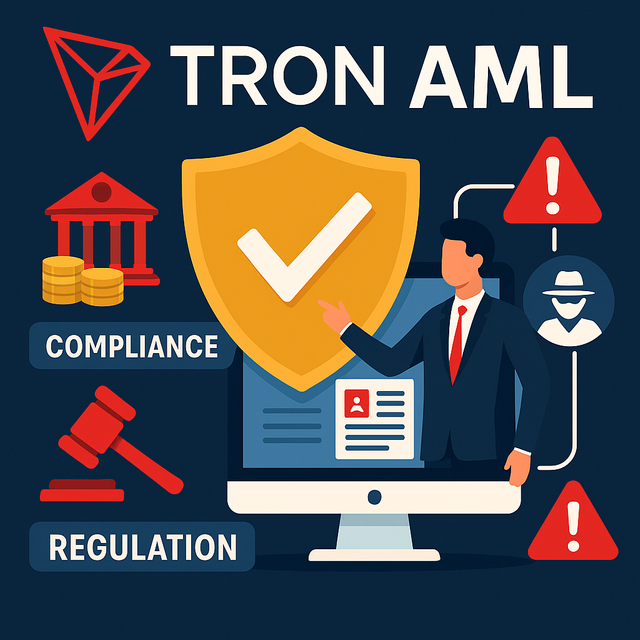Tron AML: Ensuring Regulatory Clarity and Financial Safety in Web3
Tron AML brings regulatory clarity and crypto security to Web3 finance. Learn how Tron enforces AML, secures its blockchain, and supports compliant decentralized innovation.
As the blockchain ecosystem transitions into Web3, the fusion of decentralization and compliance becomes increasingly vital. Tron AML—the Anti-Money Laundering framework operating across the Tron blockchain—is central to this transformation. By embedding transparency and traceability into its architecture, Tron demonstrates that innovation and regulation can co-exist in the decentralized world.
In this extended article, we’ll examine how Tron AML impacts decentralized applications, smart contracts, institutional trust, and future Web3 adoption. We'll also answer top AML-related questions to clarify how these processes function in a decentralized environment.
Understanding the Role of AML in Tron’s Web3 Architecture
AML regulations are designed to prevent financial crimes like money laundering, terrorist financing, and fraud. On Tron, these regulations are applied across a wide spectrum of activities including:
Token creation and transfer
Smart contract executions
DeFi lending and borrowing
Stablecoin remittance
Since Web3 thrives on openness and accessibility, Tron AML uses sophisticated monitoring tools and smart contract-level features to maintain compliance without sacrificing decentralization.
Tron AML and Institutional Readiness
One of the biggest challenges facing blockchain projects is attracting institutional adoption. Firms like investment banks, hedge funds, and fintech startups must comply with global financial laws. Tron AML enables this by:
Verifying user identity via KYC integrations
Logging activity on-chain for regulatory auditing
Preventing interaction with blacklisted or sanctioned wallets
With these capabilities, the Tron blockchain becomes a trusted platform for enterprise-grade applications.
Advanced Technologies Powering Tron AML
Tron AML is driven by partnerships with leading blockchain intelligence firms. These include:
Chainalysis: For real-time monitoring of suspicious wallet clusters
Elliptic: For forensic analysis and risk scoring
AMLBot: For API-based blacklist checks
These tools integrate with smart contracts, decentralized exchanges (DEXs), and dApp interfaces—ensuring compliance is baked into the entire ecosystem.
How Tron Developers Integrate AML
Developers building on Tron must adopt a compliance-by-design mindset. This includes:
Enabling wallet screening APIs before executing transactions
Creating smart contracts that reject flagged addresses
Designing AML-compliant frontends with user risk scoring
Logging metadata for internal review or external audit
These practices not only protect the project from legal risks but also build user confidence and exchange partnerships.
Real Impact: Tron AML in Action
Let’s explore practical scenarios where AML makes Tron more secure:
USDT Transfers on Tron: Often used for remittances, these are monitored for large or unusual volumes.
TRC-20 Token Launches: Participants must be verified to prevent regulatory breaches.
Tron-based Gambling Platforms: AML reduces the chance of illicit financial behavior in high-volume betting dApps.
In all these cases, AML ensures that activity remains traceable, legal, and transparent.
FAQs About Tron AML
Q1: Can a DeFi project on Tron operate without AML features?
Technically yes, but it risks exchange bans, user distrust, and legal issues. AML compliance is now a baseline for credibility.
Q2: Is using Chainalysis mandatory for Tron dApps?
No, but many use it or similar services to meet AML standards and gain legitimacy.
Q3: What is the role of KYC in Tron AML?
KYC (Know Your Customer) is often the first layer of AML. Though Tron itself is permissionless, dApps and exchanges can require KYC to stay compliant.
Q4: How do AML smart contracts work?
These contracts contain pre-built logic to block blacklisted addresses, enforce limits, and provide audit logs.
Q5: Can Tron AML stop scams or rug pulls?
While no system is perfect, AML significantly reduces these risks by filtering bad actors and making activity visible to monitors.
Q6: What happens when a wallet is flagged?
Exchanges may freeze funds. dApps may restrict access. Alerts are shared with global compliance networks.
Q7: How is Tron AML evolving?
Expect integration with AI fraud detection, zero-knowledge compliance proofs, and cross-chain blacklist syncs.
Conclusion: Tron AML Is the Future of Responsible Web3 Finance
As blockchain goes mainstream, Tron AML ensures that this progress happens safely, legally, and transparently. Whether you're a developer, trader, regulator, or institution, understanding and supporting AML on Tron is key to unlocking sustainable innovation.
By fusing smart compliance tools with decentralized architecture, Tron proves that Web3 doesn’t have to be lawless—it can lead the way in responsible digital finance.
